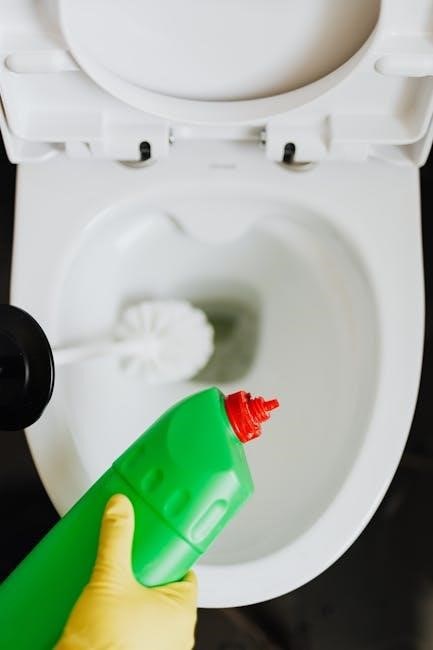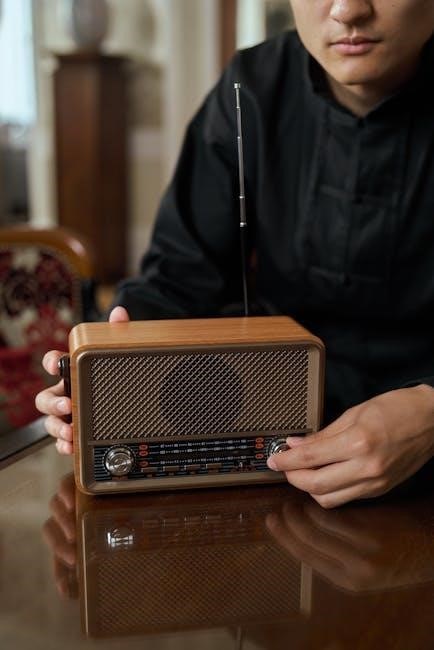Welcome to the Merlin at Home Transmitter Manual, your comprehensive guide to understanding and operating the Merlin home transmitter․ This manual covers setup, usage, and troubleshooting for models EX1100, EX1150, and EX1150W, ensuring seamless remote monitoring and data transmission for optimal health management․
Overview of the Merlin Home Transmitter System
The Merlin Home Transmitter System is a cutting-edge remote monitoring solution designed to collect and transmit data from implanted medical devices․ It supports models EX1100, EX1150, and EX1150W, enabling seamless communication between patients and healthcare providers․ The system automatically monitors implantable devices, such as pacemakers or ICDs, and transmits critical data to a secure server for clinician review․ This allows for timely interventions and continuous patient care․ The transmitter is compatible with cellular adapters, ensuring reliable data transmission even in remote locations․ Initial setup requires manual configuration, but once operational, the system runs automatically, providing peace of mind for patients․ Additionally, the Merlin Home Transmitter supports remote follow-ups, reducing the need for in-person clinic visits․ This manual provides detailed instructions for setup, troubleshooting, and maintenance, ensuring optimal performance and patient safety․ By following the guidelines, users can maximize the benefits of remote monitoring and maintain seamless connectivity with their healthcare team․

System Requirements and Compatibility
The Merlin Home Transmitter is compatible with models EX1100, EX1150, and EX1150W, ensuring reliable data transmission․ It works seamlessly with cellular adapters and supports remote monitoring, making it a versatile solution for various healthcare needs․
Supported Models: EX1100, EX1150, and EX1150W

The Merlin Home Transmitter is designed to support specific models, including the EX1100, EX1150, and EX1150W․ These models are engineered to provide reliable performance and compatibility with various implanted devices․ The EX1100 offers basic functionality, while the EX1150 and EX1150W include advanced features such as wireless connectivity and enhanced data transmission․ The EX1150W specifically supports Wi-Fi capabilities, ensuring a seamless connection to your home network․ Each model is tailored to meet different patient needs, ensuring that users can monitor their health effectively from the comfort of their homes․ With these models, you can trust that your data will be transmitted securely and efficiently to your healthcare provider․ Regular software updates are recommended to maintain optimal performance and security across all supported models․
Compatibility with Cellular Adapters
The Merlin Home Transmitter is designed to work seamlessly with cellular adapters, ensuring reliable data transmission even in areas with limited internet access․ This feature is particularly useful for remote monitoring, as it allows the transmitter to connect to cellular networks for uninterrupted communication with your healthcare provider․ The EX1100, EX1150, and EX1150W models are all compatible with cellular adapters, though specific configurations may vary depending on the model and regional network requirements․ For optimal performance, it is recommended to use a cellular adapter that supports the same frequency bands as your local network․ The transmitter automatically detects and pairs with compatible adapters, minimizing setup complexity․ This adaptability ensures that patients can maintain consistent remote monitoring, regardless of their location or internet availability․ Always consult the manual or contact technical support for specific adapter recommendations and configuration guidance․

Setting Up the Merlin Home Transmitter
Setting up the Merlin Home Transmitter is straightforward, requiring minimal technical expertise․ Follow the manual’s step-by-step guide to ensure proper installation, configuration, and connection to your implant for reliable data transmission․
Physical Setup and Installation
Begin by carefully unpacking the Merlin Home Transmitter and its accessories․ Ensure all components, including the transmitter unit, power adapter, and connection cables, are included․ Place the transmitter on a stable, flat surface in a well-ventilated area․ Connect the power adapter to the transmitter and plug it into a nearby electrical outlet․ Next, locate a suitable phone jack for the transmitter’s telephone connection, ensuring it is easily accessible․ If using a cellular adapter, follow the specific installation instructions provided with the adapter․ Once all physical connections are secure, proceed to power on the transmitter and allow it to initialize․ Refer to the manual for detailed diagrams and step-by-step instructions to ensure proper installation․ Proper physical setup is crucial for optimal performance and reliable data transmission․
Connecting the Transmitter to Your Implant
To connect the Merlin Home Transmitter to your implant, start by placing the transmitter in close proximity to your implanted device․ Ensure the transmitter is powered on and in standby mode․ The transmitter will automatically detect and synchronize with your implant once it is within range․ You may see an indicator light flash during the pairing process․ If the connection is successful, you will receive a confirmation, such as an audible beep or a visual prompt on the transmitter․ If the transmitter does not detect your implant, check the distance and ensure there are no obstructions․ Repositioning the transmitter or moving closer to the implant may resolve the issue․ For detailed pairing instructions, refer to the step-by-step guide in the manual․ Proper connection ensures accurate data transmission and reliable monitoring of your implant activity․
Initial Configuration and Manual Transmission

After setting up the Merlin Home Transmitter, proceed to the initial configuration․ Open the Merlin software on your computer or mobile device and follow the on-screen instructions to register your transmitter․ This step is essential for linking your device to your clinic’s system․ Once configured, perform a manual transmission to test the setup․ To initiate manual transmission, press and hold the transmit button on the transmitter until the indicator light starts flashing․ This indicates that data is being sent․ Ensure your implant is within range and the transmitter is connected to a power source․ If the transmission is successful, you will receive confirmation․ If it fails, check the connection steps or restart the process․ Regular manual transmissions may be requested by your clinic to ensure continuous monitoring․ For troubleshooting, refer to the manual or contact technical support for assistance․

Troubleshooting Common Issues
Common issues with the Merlin Home Transmitter include connection problems and failed manual transmissions․ Check the wall jack and phone connector, ensure the transmitter is powered on, and restart the system if necessary․
Resolving Connection Problems with the Transmitter
If you encounter connection issues with your Merlin home transmitter, start by verifying the physical connections․ Ensure the transmitter is properly plugged into the wall jack and that all cables are securely attached․ Next, check for any interference from other electronic devices nearby․ Restart the transmitter and your implanted device to reset the connection․ If issues persist, ensure your transmitter is updated with the latest software․ Contact your clinic or technical support for further assistance if problems remain unresolved․ Regularly checking these connections and maintaining proper setup can help prevent future issues and ensure reliable data transmission․ Always refer to the manual for detailed troubleshooting steps tailored to your specific model, such as EX1100, EX1150, or EX1150W․
Troubleshooting Manual Transmission Failures
If manual transmission fails, ensure the transmitter is properly connected to both the wall jack and your implant․ Verify that all cables are securely plugged in and free from damage․ Restart the transmitter and retry the manual transmission process․ Check for any interference from nearby electronic devices, as this can disrupt the signal․ Ensure your transmitter is updated with the latest software, as outdated versions may cause compatibility issues․ If transmission still fails, refer to the user manual for specific troubleshooting steps for your model (EX1100, EX1150, or EX1150W)․ Contact your clinic or technical support for assistance if the problem persists․ Regular maintenance and updates can help prevent future issues and ensure reliable data transmission․ Always follow the guidelines provided in the manual for your specific device to resolve manual transmission failures effectively․

Maintenance and Care
Regularly update software and firmware to ensure optimal performance․ Check connections and cables for damage․ Restart the transmitter periodically to maintain functionality․ Clean the device with a damp cloth, avoiding submersion in water․ Always follow manual guidelines for proper care․
Best Practices for Transmitter Maintenance
Regularly inspect the transmitter for dust or debris and clean it with a soft, dry cloth․ Avoid submerging the device in water or exposing it to extreme temperatures․ Ensure all cables and connections are secure and free from damage․ Periodically restart the transmitter to refresh its system․ Always update the software and firmware as prompted to maintain optimal performance․ Store the transmitter in a dry, cool place when not in use․ Avoid placing heavy objects on the device or bending the cables excessively․ For prolonged storage, follow the manual’s guidelines to preserve functionality․ By adhering to these practices, you can extend the lifespan of your Merlin at Home Transmitter and ensure reliable operation during remote monitoring sessions․
Updating Software and Firmware
Regular software and firmware updates are essential to ensure your Merlin at Home Transmitter operates efficiently and securely․ To update, connect the transmitter to a computer or use a cellular adapter, depending on your model․ Log in to the Merlin software and navigate to the “Updates” section․ Follow the on-screen instructions to download and install the latest version․ Never interrupt the update process, as this could cause system errors․ After completion, restart the transmitter to apply changes․ Always verify that the update was successful by checking the version number in the settings menu․ If issues arise, refer to the manual or contact technical support․ Keeping your transmitter updated ensures compatibility with your implant, enhances performance, and protects against potential security vulnerabilities․ Stay informed about new releases through notifications or periodic checks on the Merlin portal․ Regular updates are crucial for maintaining reliable remote monitoring and data transmission․

Remote Monitoring and Follow-Ups
The Merlin at Home Transmitter enables seamless remote monitoring, allowing your clinic to access real-time data from your implant․ Regular follow-ups ensure continuous health tracking and timely interventions, enhancing your care experience remotely․
Understanding Remote Follow-Up Sessions
Remote follow-up sessions with the Merlin at Home Transmitter allow your healthcare provider to monitor your implant data without an in-person visit․ These sessions are scheduled by your clinic and typically occur at regular intervals to ensure your device is functioning correctly and your health is being closely tracked․ During a session, the transmitter collects data from your implant and sends it securely to your clinic via a cellular or internet connection․ This data includes information about your heart rhythm, device settings, and battery life․ Your clinic will analyze the data and may adjust your device settings remotely if needed․ Remote follow-ups save time, reduce the need for travel, and provide peace of mind by maintaining consistent communication with your healthcare team․ It’s important to follow the setup instructions provided in the manual to ensure reliable data transmission during these sessions․
Preparing for Remote Monitoring
To ensure successful remote monitoring with your Merlin at Home Transmitter, proper preparation is essential․ Begin by confirming that your transmitter is fully set up and connected to your implant․ Verify that all physical connections, such as the phone jack or cellular adapter, are secure․ Ensure your internet or cellular connection is stable, as disruptions can interfere with data transmission․ Keep the transmitter in an open area, away from obstacles or electronic devices that may cause interference․ Charge the transmitter according to the manual’s instructions to avoid power issues during monitoring․ Familiarize yourself with the manual’s troubleshooting section to address any unexpected issues quickly․ Finally, schedule a quiet, uninterrupted time for the monitoring session and ensure you are available to respond to any prompts or alerts from the system․ Proper preparation ensures accurate data collection and a seamless remote monitoring experience․

Data Management and Security
The Merlin at Home Transmitter ensures secure data management by encrypting all transmissions․ Patient information is protected through advanced security protocols, maintaining confidentiality and compliance with data protection regulations․
How Data is Collected and Transmitted
The Merlin at Home Transmitter collects data from your implanted device during scheduled remote follow-ups or manual transmissions․ Once connected, the transmitter reads and processes the information, encrypting it for secure transmission to a designated server; This ensures that your clinic can access real-time data for monitoring and analysis․ The process is automated, but manual transmission can be initiated if required by your healthcare provider․ The transmitter uses cellular or internet connectivity to send data, maintaining high levels of security and reliability․ This seamless process allows for continuous monitoring and timely medical interventions, enhancing patient care and outcomes․ The system is designed to be user-friendly, ensuring that data collection and transmission are efficient and stress-free for patients․
Ensuring Patient Data Privacy
Protecting patient data is a top priority for the Merlin at Home Transmitter system․ All transmitted data is encrypted to prevent unauthorized access, ensuring confidentiality and integrity․ The system adheres to strict data protection regulations, such as HIPAA, to safeguard sensitive medical information․ Secure authentication methods are used to verify both the transmitter and the receiving server, minimizing the risk of data breaches․ Additionally, the Merlin home transmitter operates on encrypted channels, further enhancing data security․ Regular software updates are provided to maintain the highest security standards and protect against potential vulnerabilities․ Patients can trust that their health information remains private and secure throughout the transmission process․ The system is designed to comply with global data privacy standards, ensuring that patient confidentiality is upheld at all times․ This robust security framework allows patients to use the Merlin at Home Transmitter with confidence, knowing their data is protected․
Security Measures for Transmitted Information
The Merlin at Home Transmitter employs advanced security measures to safeguard transmitted information․ Data encryption ensures that all communications between the transmitter and the server are secure, protecting against unauthorized access․ The system uses secure authentication protocols to verify both the transmitter and the receiver, ensuring that data is only sent to authorized entities․ Additionally, the transmitter operates on encrypted communication channels, further reducing the risk of data interception․ Regular software updates are provided to maintain the highest level of security and address any potential vulnerabilities․ The system is designed to comply with strict regulations, such as HIPAA, to ensure patient data remains confidential․ These robust security measures provide peace of mind for patients using the Merlin at Home Transmitter, knowing their health information is transmitted securely․ The encryption and authentication processes are continuously monitored to ensure the integrity of the data transmission process․

Additional Resources and Support
For further assistance, visit the official Merlin at Home Transmitter Manual PDF or contact technical support and clinics for detailed guidance and troubleshooting․ Additional resources are available online for optimal system utilization and maintenance․
Accessing the Merlin Home Transmitter Manual PDF
The Merlin Home Transmitter Manual PDF is readily available for download from the official St․ Jude Medical website or through your healthcare provider․ This comprehensive guide provides detailed instructions for setting up, operating, and troubleshooting your Merlin home transmitter․ To access the manual, visit the official website and navigate to the support section․ Enter your transmitter model number (e․g․, EX1100, EX1150, or EX1150W) in the search bar to find the corresponding PDF․ Ensure you download the correct version for your specific device to avoid confusion․ The manual is designed to be user-friendly, covering topics such as physical setup, connecting to your implant, and initial configuration․ If you encounter difficulties finding the PDF, contact your clinic or technical support for assistance․ This resource is essential for maximizing the functionality and efficiency of your Merlin home transmitter․
Contacting Technical Support and Clinics
If you need assistance with your Merlin home transmitter, contacting technical support or your clinic is the best course of action․ St․ Jude Medical provides dedicated support to ensure your device functions optimally․ You can reach technical support via phone or email, and their team is available to address any issues, from troubleshooting to software updates․ Additionally, your healthcare clinic is a valuable resource for guidance and support․ They can provide personalized assistance, answer questions about your transmitter, and help resolve any difficulties you may encounter;
When contacting support, have your transmitter model number (e․g․, EX1100, EX1150, or EX1150W) and any error messages ready․ This will help the support team quickly identify and address your specific issue․ For non-urgent inquiries, you can also refer to the Merlin Home Transmitter Manual PDF or the official website for additional resources․ Remember, both technical support and your clinic are here to ensure your experience with the Merlin home transmitter is smooth and effective․
The Merlin home transmitter revolutionizes remote monitoring and data transmission for EX1100, EX1150, and EX1150W models, ensuring seamless health management․ Future updates promise enhanced integration with emerging medical technologies․
Final Thoughts on Using the Merlin Home Transmitter
The Merlin home transmitter is a powerful tool designed to enhance remote monitoring and data transmission for patients with compatible medical devices․ By following the guidelines outlined in this manual, users can ensure seamless operation and optimal performance․ The transmitter’s compatibility with models EX1100, EX1150, and EX1150W makes it a versatile solution for various patient needs․ Regular maintenance, software updates, and adherence to best practices are essential for longevity and reliability․ Patients should feel confident in their ability to manage their health remotely, knowing they have access to comprehensive support resources․ As technology advances, future updates will likely bring even greater functionality and integration․ For any difficulties, contacting technical support or your clinic is strongly recommended․ With proper use, the Merlin home transmitter can significantly improve health monitoring and management, offering peace of mind for patients and healthcare providers alike․
